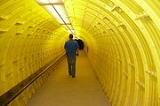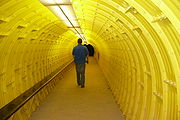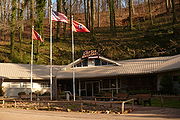
Craighead Caverns
Encyclopedia

Sweetwater, Tennessee
Sweetwater is a city in Monroe and McMinn counties in the U.S. state of Tennessee, and the most populous city in Monroe County. The population was 5,586 at the 2000 census. Sweetwater is the home of the Craighead Caverns which contains the Lost Sea, the United States' largest underground...
, Tennessee
Tennessee
Tennessee is a U.S. state located in the Southeastern United States. It has a population of 6,346,105, making it the nation's 17th-largest state by population, and covers , making it the 36th-largest by total land area...
. It is best known for containing the United States
United States
The United States of America is a federal constitutional republic comprising fifty states and a federal district...
' largest and World's second largest underground lake, The Lost Sea. In addition to the lake, the caverns contain an abundance of crystal clusters called anthodite
Anthodite
Anthodites are speleothems composed of long needle-like crystals situated in clusters which radiate outward from a common base. The "needles" may be quill-like or feathery...
s, stalactites, stalagmite
Stalagmite
A stalagmite is a type of speleothem that rises from the floor of a limestone cave due to the dripping of mineralized solutions and the deposition of calcium carbonate. This stalagmite formation occurs only under certain pH conditions within the underground cavern. The corresponding formation on...
s and a waterfall.
History

Foothills
Foothills are geographically defined as gradual increases in elevation at the base of a mountain range. They are a transition zone between plains and low relief hills to the adjacent topographically high mountains.-Examples:...
of the Great Smoky Mountains
Great Smoky Mountains
The Great Smoky Mountains are a mountain range rising along the Tennessee–North Carolina border in the southeastern United States. They are a subrange of the Appalachian Mountains, and form part of the Blue Ridge Physiographic Province. The range is sometimes called the Smoky Mountains or the...
, the caverns are named after their former owner, a Cherokee
Cherokee
The Cherokee are a Native American people historically settled in the Southeastern United States . Linguistically, they are part of the Iroquoian language family...
native American
Native Americans in the United States
Native Americans in the United States are the indigenous peoples in North America within the boundaries of the present-day continental United States, parts of Alaska, and the island state of Hawaii. They are composed of numerous, distinct tribes, states, and ethnic groups, many of which survive as...
, Chief Craighead. The caverns were formerly used by the Cherokee as a meeting place and later they were mined by Confederate
Confederate States of America
The Confederate States of America was a government set up from 1861 to 1865 by 11 Southern slave states of the United States of America that had declared their secession from the U.S...
soldiers for saltpeter
Potassium nitrate
Potassium nitrate is a chemical compound with the formula KNO3. It is an ionic salt of potassium ions K+ and nitrate ions NO3−.It occurs as a mineral niter and is a natural solid source of nitrogen. Its common names include saltpetre , from medieval Latin sal petræ: "stone salt" or possibly "Salt...
, a commodity necessary to the manufacture of gunpowder
Gunpowder
Gunpowder, also known since in the late 19th century as black powder, was the first chemical explosive and the only one known until the mid 1800s. It is a mixture of sulfur, charcoal, and potassium nitrate - with the sulfur and charcoal acting as fuels, while the saltpeter works as an oxidizer...
.
In 1939, explorers found the remains of a Pleistocene
Pleistocene
The Pleistocene is the epoch from 2,588,000 to 11,700 years BP that spans the world's recent period of repeated glaciations. The name pleistocene is derived from the Greek and ....
jaguar
Jaguar
The jaguar is a big cat, a feline in the Panthera genus, and is the only Panthera species found in the Americas. The jaguar is the third-largest feline after the tiger and the lion, and the largest in the Western Hemisphere. The jaguar's present range extends from Southern United States and Mexico...
. The persons who made the discovery were cave guides Jack Kyker and Clarence Hicks, who were exploring in the cave during their off hours. They reported their find to Dr. W. J. Cameron and W. E. Michael of Sweetwater, who were the current owners of the cave. The owners submitted the bones to the American Museum of Natural History in New York City, where they were identified as bones of a very large jaguar and an elk fawn. George Gaylord Simpson, a vertebrate paleontologist at the museum, subsequently visited Craighead Caverns in May, 1940 where he recovered additional jaguar bones and made casts of several jaguar footprints in the mud floor of the cave. His excavation and findings are reported in American Museum Novitates, No. 1131 (August 6, 1941) on pages 1–12. The report includes photographs of the bones and footprints.
A mushroom farm was operated in the cave from 1939 to 1940. The manure for this operation was supplied from Fort Oglethorpe, where many horses were stabled. The mushroom beds were located in the Big Room, a few hundred feet northeast of the Historic Entrance. In 1947, a wooden dance floor was built in this same area of the cave, and a nightclub, known as the "Cavern Tavern", was operated in the cave.
Craighead Caverns was added to the National Park Service
National Park Service
The National Park Service is the U.S. federal agency that manages all national parks, many national monuments, and other conservation and historical properties with various title designations...
list of National Natural Landmark
National Natural Landmark
The National Natural Landmark program recognizes and encourages the conservation of outstanding examples of the natural history of the United States. It is the only natural areas program of national scope that identifies and recognizes the best examples of biological and geological features in...
s in 1973.
The Lost Sea

The visible surface of the lake measures 800 feet long and 220 feet wide (4.5 acres) at normal "full" capacity. Cave divers have explored several rooms that are completely filled with water, without reaching the end of the cave. This exploration was conducted in the 1970s.
For many years The Lost Sea was considered the world's largest underground lake and is still recognized as the world's second largest underground lake.
Boat tours of the lake are still given and for many people are the highlight of the tour. In times of extreme drought (such as 2007-08) the lake recedes significantly and the management had to extend the walkway and the boat dock in order to be able to provide the boat tours. According to the management of the Lost Sea, the water level in the lake dropped 28 feet below its normal level at the height of the drought. At such times visitors see a much larger cavern above the lake surface.
Further reading
- Larry E. Matthews, Caves of Knoxville and the Great Smoky Mountains, 2008, Published by the National Speleological Society, 296 pages, ISBN 978-1-879961-30-2. Chapter 10 - The Lost Sea, pp 181–210.
External links
- The Lost Sea website
- America's Little-Known Natural Wonders: Spectacular destinations you may not know about, By Christopher Vourlias, Forbes Traveler via Yahoo Traveler, 9/1/09.
- Jim Wyatt's account of his underwater exploration, By Jim Wyatt on http://www.thedecostop.com 08/24/2005

